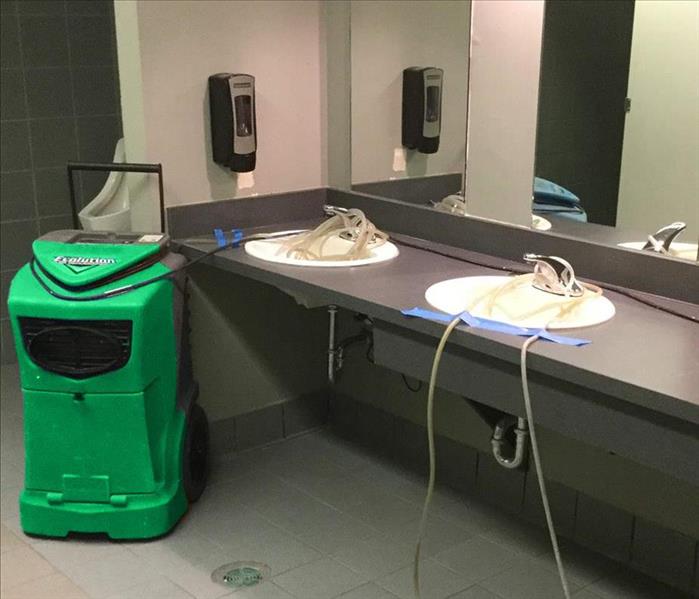How Dehumidifiers Work and Their Importance in Restoration
5/26/2021 (Permalink)
 A dehumidifier removes moisture from the air and helps prevent the creation of an environment for mold growth to thrive in.
A dehumidifier removes moisture from the air and helps prevent the creation of an environment for mold growth to thrive in.
What Is a Dehumidifier and What Does It Do?
A dehumidifier is an electrical machine used to extract excess humidity or foul smells from the air. It is also great for mold prevention. Moisture levels in a building come from several things. Improper room ventilation while cooking and drying laundry makes house walls sweat. A room filled with strange odors, humidity, and particles is agonizing for people suffering from asthma or allergies.
Relief from Water Damage and Mold
Busted pipes, leaky roofs, or flooding challenges attracts potentially dangerous mold. If mold spores come in contact with damp or wet spaces, it grows and can potentially become toxic.
Homeowners and Business owners must stay abreast of any water leakages or flooding on the inside of the structure. Renovations due to excess water damage and mold can be costly. A dehumidifier is the best choice if your goal is to put a stop to mold. Mold lurks in damp environments.
A dehumidifier draws in the moist, humid air through an evaporator coil then through a condenser coil. This procedure transforms the previous moist, damp air into warm air. Once the air is warmed, it is then released back into the room while at the same time lowering the humidity within the building.
A significant issue that can occur within a business or housing complex is mold growth. However, when discovered right away, the risk is reduced to minimal. The key to preventing mold is finding where the issue occurred and extracting excess water as soon as possible. Once you locate the leak source, use water removal instruments to dry up the excess water.
The Functions, Pros, and Cons: Dehumidifiers and an Air Exchangers
A dehumidifier is similar to an air conditioner. Air coolers are for circulating cool air into a specific area of a structure. Keep in mind that ideal air circulation calls for fans and windows. It is also good to know that different types of wood or materials react differently to water.
An air conditioner cools the air down but can make for a humid, moist environment. In contrast, a dehumidifier dries the air, making it warmer, plus decreasing the humidity. Conventional AC units remove the moisture by cooling the air.
The size of the unit is essential to ensure the room cools quickly and efficiently. For instance, using a tiny air unit to cool a large area is a waste of energy and will empty your wallet. Switching to an air inverter conditioning system is an energy-efficient alternative to conventional air exchangers.
Window-mounted air exchange units do not always vent adequately. Because air exchangers are typically either on the outside fully or partially, the air travels through a wall vent, then through the evaporator. Finally, in the condenser coil, the warm air shoots outside the structure. Obstructions in a wall-mounted air unit reduce airflow, and the air conditioner unit gets overheated.
Cleaning up the Mess
Some water cleanups and restorations may require pumps and professional drying systems to dry excess water from walls, carpets, and ceilings. Also, be aware that materials do not react the same when they come in contact with water. Warning, if you do not know how to extract excess water from a structure, please call a professional. It is imperative to use the right tools and protective equipment.
A professional will extract and mitigate (remove damaged materials) from the site. A professional uses precision moisture meters and thermal devices to pinpoint where the problem lies. It is crucial to keep in mind that water extractions can run you into thousands of dollars. Professionals require various types of tools for professional water damage restoration.
Air coolers maintain constant humidity levels, therefore preventing mold from forming. Air movers also blast out stuffy smells from a room. Lastly, wall or window-mounted air conditioners are easy to operate. The downside of running an AC unit around the clock, however, is enormous energy consumption.
Water extraction is necessary for massive floods such as busted pipes or natural disasters. However, for a do-it-yourself cleanup, a dehumidifier is an excellent device to get started. Even better, a dehumidifier teamed up with a commercial air mover (fan or air conditioner) works for restoring a severely damaged wet area.
Humidifiers and Air Coolers Working Together
Merging these devices is a quicker and more effective means of restoration. This method ensures that mold will not creep in at a later time. Joining an air mover with a dehumidifier reduces future damages to the structure. When it comes to decreasing moisture levels, air coolers alone cannot measure up to a dehumidifier.
An energy-efficient inverter air system can save about 70% on the next power bill. Note, however, that dehumidifiers use only a tenth of your electric power. Dehumidifiers come with built-in sensors that regulate the fan speed within the defrost system. Like other types of technology, machine technology is ever-changing.
Air conditioners alone eliminate about 18 gallons of water. Excess water causes potentially dangerous mold. Preventing mold is a primary reason people choose this duel system. Whether you choose a conventional, large, or compact dehumidifier depends on the size of the task.
An air conditioner teamed up with a dehumidifier is effective and removes moisture quicker. The main factors in getting efficient air are good circulation, dehumidification, and air purification. For specific spaces, portable AC modifiers have condenser evaporators that pull heat out of an area. These mobile units go where they are needed.





 24/7 Emergency Service
24/7 Emergency Service